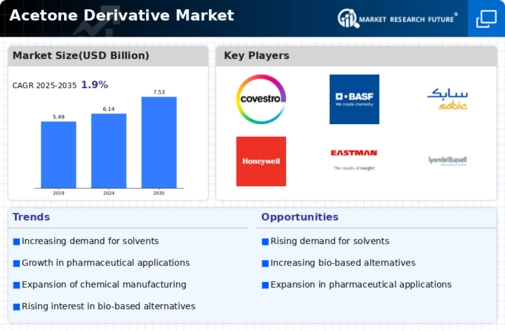Market Trends and Projections
Expansion of Pharmaceutical Sector
The Global Acetone Derivative Market Industry is significantly influenced by the expansion of the pharmaceutical sector. Acetone derivatives are integral in the synthesis of active pharmaceutical ingredients and other formulations. The ongoing advancements in drug development and the increasing prevalence of chronic diseases necessitate the use of acetone derivatives in pharmaceutical applications. As the industry adapts to these changes, the market is projected to grow at a CAGR of 1.87% from 2025 to 2035. This growth trajectory indicates a promising future for acetone derivatives as essential components in the pharmaceutical manufacturing process.
Growing Demand in Chemical Manufacturing
The Global Acetone Derivative Market Industry experiences a notable surge in demand driven by its extensive applications in chemical manufacturing. Acetone derivatives serve as essential solvents and intermediates in the production of various chemicals, including plastics and pharmaceuticals. This trend is particularly evident as the market is projected to reach 6.14 USD Billion in 2024, reflecting a robust growth trajectory. The increasing need for high-performance materials in industries such as automotive and electronics further fuels this demand, suggesting a sustained interest in acetone derivatives as critical components in innovative chemical processes.
Rising Applications in Personal Care Products
The Global Acetone Derivative Market Industry benefits from the rising applications of acetone derivatives in personal care products. These compounds are utilized as solvents and stabilizers in cosmetics, skincare, and hair care formulations. The growing consumer preference for high-quality personal care items, coupled with an increasing focus on product safety and efficacy, drives the demand for acetone derivatives. As the market evolves, it is anticipated that the industry will adapt to these trends, potentially leading to a market valuation of 7.53 USD Billion by 2035. This growth underscores the importance of acetone derivatives in meeting consumer expectations in the personal care sector.
Technological Advancements in Production Processes
Technological advancements in production processes are reshaping the Global Acetone Derivative Market Industry. Innovations in manufacturing techniques enhance the efficiency and sustainability of acetone derivative production. These advancements not only reduce production costs but also minimize environmental impact, aligning with global sustainability goals. As industries increasingly prioritize eco-friendly practices, the adoption of advanced technologies in acetone derivative production is likely to gain momentum. This shift may contribute to the overall growth of the market, as companies seek to optimize their operations while meeting regulatory standards and consumer demands.
Increasing Regulatory Compliance and Safety Standards
The Global Acetone Derivative Market Industry faces increasing regulatory compliance and safety standards that shape its operational landscape. Governments worldwide are implementing stricter regulations regarding the use of chemicals in various applications, including industrial and consumer products. This trend compels manufacturers to ensure that their acetone derivatives meet safety and environmental standards, potentially driving innovation in product formulations. As companies adapt to these regulations, the market may witness a transformation in product offerings, catering to the evolving needs of consumers and regulatory bodies alike.
























